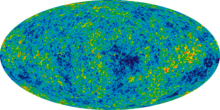
In physical cosmology, baryogenesis is the hypothetical physical processes that took place during the early universe that produced baryonic asymmetry, i.e. the imbalance of matter (baryons) and antimatter (antibaryons) in the observed universe.
Baryogenesis theories are based on different descriptions of the interaction between fundamental particles. Two main theories are electroweak baryogenesis (standard model), which would occur during the electroweak epoch, and the GUT baryogenesis, which would occur during or shortly after the grand unification epoch. Quantum field theory and statistical physics are used to describe such possible mechanisms.
Baryogenesis is followed by primordial nucleosynthesis, when atomic nuclei began to form.
The Dirac equation, formulated by Paul Dirac around 1928 as part of the development of relativistic quantum mechanics, predicts the existence of antiparticles along with the expected solutions for the corresponding particles. Since that time, it has been verified experimentally that every known kind of particle has a corresponding antiparticle. The CPT theorem guarantees that a particle and its antiparticle have exactly the same mass and lifetime, and exactly opposite charge. Given this symmetry, it is puzzling that the universe does not have equal amounts of matter and antimatter. Indeed, there is no experimental evidence that there are any significant concentrations of antimatter in the observable universe.